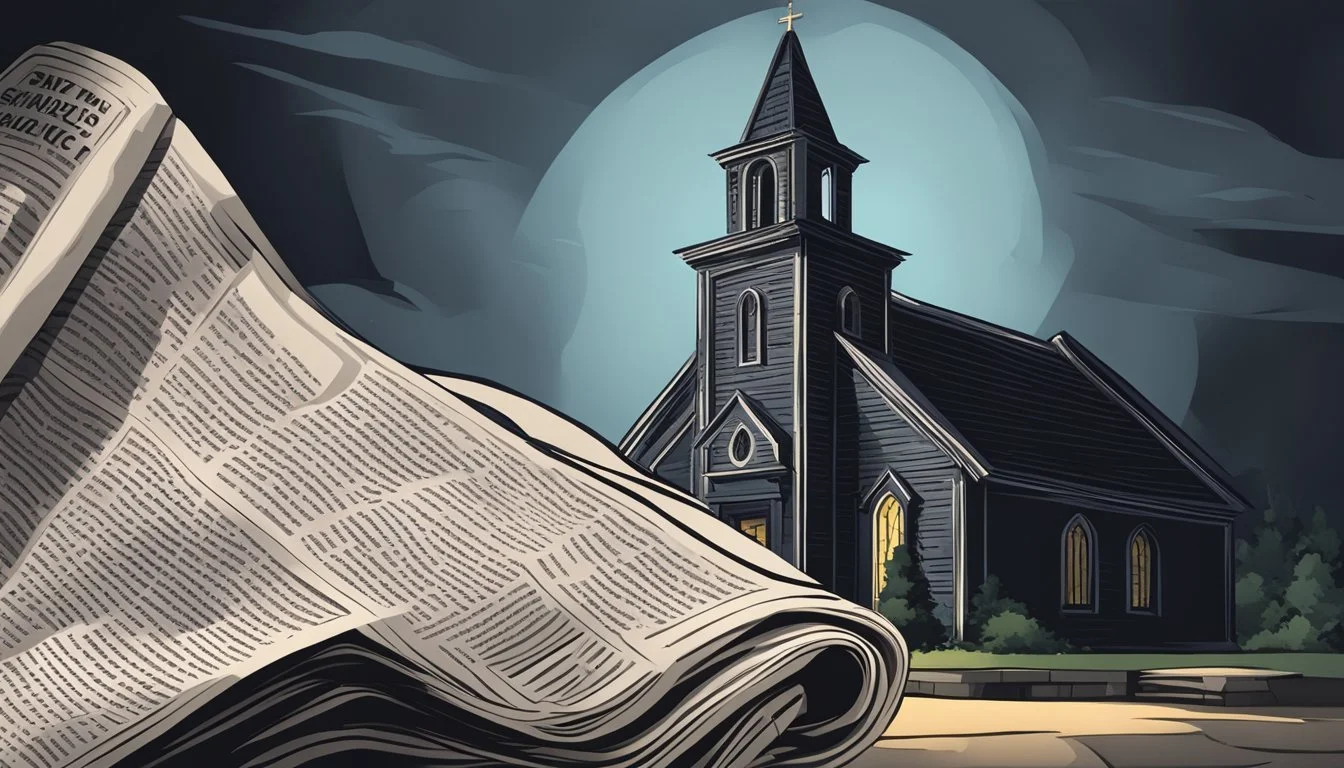The Genuine Spotlight
The Boston Globe's Church Abuse Investigation Uncovers Decades of Systemic Cover-ups
In 2001, a team of dedicated journalists at The Boston Globe embarked on a groundbreaking investigation that would shake the foundations of the Catholic Church. Their relentless pursuit of truth uncovered a systemic pattern of child sexual abuse and cover-ups within the Boston Archdiocese. The Spotlight team's exposé revealed decades of hidden scandals, implicating numerous priests and high-ranking church officials in the protection of abusers.
The investigation began under the leadership of a new Globe editor, who directed the Spotlight team to examine allegations against a single priest, John J. Geoghan. As they dug deeper, the journalists discovered a much larger web of abuse and institutional negligence. Their work culminated in a series of articles published in 2002, which not only won a Pulitzer Prize but also inspired the Academy Award-winning film "Spotlight."
The impact of the Globe's investigation extended far beyond Boston. It sparked a global reckoning within the Catholic Church, leading to reforms in how abuse allegations are handled and encouraging victims worldwide to come forward. The Spotlight team's work stands as a testament to the power of investigative journalism in exposing wrongdoing and catalyzing social change.
Background of the Investigation
The Boston Globe's investigation into clergy sexual abuse emerged from the paper's longstanding commitment to investigative journalism. It began with the formation of a specialized reporting team dedicated to in-depth, long-term investigations of significant public interest.
The Boston Globe's Editorial Mission
The Boston Globe has a rich history of pursuing hard-hitting investigative stories. Founded in 1872, the newspaper built its reputation on uncovering corruption and wrongdoing in Boston and beyond. By the early 2000s, the Globe had established itself as a leader in investigative reporting, winning numerous awards for its in-depth coverage of complex issues.
The paper's editorial leadership prioritized stories that could drive meaningful change in society. This commitment to impactful journalism set the stage for the Globe's investigation into the Catholic Church scandal.
Formation of the Spotlight Team
In 1970, the Boston Globe created the Spotlight Team, a dedicated group of investigative reporters. This team was tasked with tackling complex, long-term investigations that required extensive research and reporting.
The Spotlight Team operated independently from the daily news cycle, allowing members to spend months or even years on a single story. In 2001, then-editor Martin Baron directed the team to investigate allegations of clergy sexual abuse.
Key members of the Spotlight Team during the church investigation included Walter Robinson, Michael Rezendes, Sacha Pfeiffer, and Matt Carroll. Their combined expertise in investigative techniques and dogged pursuit of the truth proved crucial to uncovering the scandal.
Uncovering the Scandal
The Boston Globe's Spotlight team meticulously investigated the Catholic Church's sexual abuse cover-up. Their groundbreaking work exposed systemic misconduct and institutional failings on a massive scale.
Initial Leads and Research
The investigation began in 2001 when a new Globe editor arrived. He pushed the Spotlight team to examine allegations against a local priest. This led them to uncover a much wider pattern of abuse and concealment within the Catholic Church.
The reporters started by reviewing court records and interviewing victims. They discovered that the Archdiocese of Boston had secretly settled numerous abuse cases. This raised red flags about the church's handling of predatory priests.
The team compiled a database of priests accused of sexual misconduct. They cross-referenced it with parish records to track suspicious transfers of clergy members.
Challenges and Breakthroughs
Investigating such a powerful institution posed significant obstacles. Many victims were reluctant to speak out due to shame or fear. Church officials stonewalled requests for information.
A key breakthrough came when the team obtained internal church documents. These memos revealed that top leaders knew about abusive priests but failed to remove them from ministry.
The reporters faced intense pressure and criticism from some members of Boston's heavily Catholic community. They persevered, driven by a commitment to expose the truth and protect children.
Key Interviews and Evidence
Interviews with victims provided crucial firsthand accounts of abuse. The team spoke with dozens of survivors, carefully verifying their stories.
Former priests and church insiders offered valuable perspectives on the internal workings of the archdiocese. Their testimony helped confirm the systematic nature of the cover-up.
Court records proved instrumental in building the case. The team successfully fought to unseal documents related to abuse settlements. These records contained damning evidence of the church's efforts to shield predatory priests from exposure and prosecution.
Impact of the Publication
The Boston Globe's Spotlight investigation into clergy sexual abuse had far-reaching consequences. It sparked immediate reactions, raised global awareness, and led to significant policy changes and legal actions.
Immediate Reactions
The publication of the Spotlight team's findings sent shockwaves through Boston and beyond. Many Catholics expressed disbelief, anger, and betrayal. Church attendance dropped in the wake of the revelations. Some parishioners demanded accountability from church leaders.
Victims of abuse felt vindicated, with many coming forward to share their own experiences. Support groups for survivors saw increased membership. The Archdiocese of Boston faced intense scrutiny and public pressure.
Cardinal Bernard Law, then-archbishop of Boston, initially downplayed the reports. As more evidence emerged, he was forced to acknowledge the extent of the problem. Law eventually resigned in December 2002 amid mounting criticism of his handling of abusive priests.
Global Awareness
The Spotlight investigation ignited similar inquiries worldwide. News organizations in other countries began investigating clergy abuse in their regions. Ireland, Australia, and Germany were among the nations where major scandals subsequently came to light.
The Vatican could no longer ignore the issue. Pope John Paul II called American cardinals to Rome in April 2002 to address the crisis. The meeting marked a shift in the Church's approach to abuse allegations.
Films like "Spotlight" (2015) brought the story to an even wider audience. The movie won the Academy Award for Best Picture, further cementing the investigation's place in public consciousness.
Policy Changes and Legal Actions
The exposé prompted significant reforms within the Catholic Church. In 2002, the U.S. Conference of Catholic Bishops adopted a "zero tolerance" policy for abusive priests. New procedures were implemented for reporting and investigating abuse allegations.
Many dioceses established victim compensation funds. The Archdiocese of Boston alone paid over $85 million to settle lawsuits from abuse survivors.
State legislatures took action as well. Several states extended or eliminated statutes of limitations for child sexual abuse cases. This allowed more victims to seek justice through the legal system.
Law enforcement agencies became more proactive in investigating clergy abuse. Some states launched their own inquiries into diocesan records.
Profiles of the Investigative Team
The Boston Globe's Spotlight team consisted of dedicated journalists who worked tirelessly to uncover the truth. Their diverse backgrounds and skills proved crucial in exposing the widespread sexual abuse within the Catholic Church.
Editors and Lead Reporters
Walter "Robby" Robinson led the Spotlight team as editor. His experience and leadership guided the investigation. Michael Rezendes, a tenacious reporter, pursued key leads and conducted critical interviews. Sacha Pfeiffer brought empathy and skill to victim interviews, helping survivors share their stories.
Matt Carroll's data analysis expertise uncovered patterns of abuse and cover-ups. Ben Bradlee Jr., as deputy managing editor, provided oversight and support to the team. Marty Baron, the Globe's new editor-in-chief, pushed for the investigation despite potential backlash.
Supportive Staff and Contributors
Stephen Kurkjian, a veteran investigative reporter, offered valuable insights and contacts. Thomas Farragher contributed additional reporting to bolster the team's findings.
Researchers and fact-checkers meticulously verified information to ensure accuracy. Legal counsel advised on potential issues and reviewed articles before publication.
Copy editors refined the team's writing for clarity and impact. Graphic designers created compelling visuals to illustrate the scope of abuse. The Globe's management provided resources and defended the investigation against external pressures.
Methodology of the Investigation
The Boston Globe's Spotlight team employed rigorous investigative techniques to uncover the Catholic Church abuse scandal. Their approach combined meticulous research, data analysis, and ethical reporting practices.
Research Approaches
The Spotlight team began by examining court records and legal documents related to abuse allegations. They cross-referenced this information with Church directories to identify patterns of priest reassignments. Journalists conducted extensive interviews with victims, lawyers, and former Church officials to gather firsthand accounts and corroborating evidence.
Team members analyzed thousands of pages of Church documents, looking for evidence of cover-ups or mishandling of abuse cases. They created detailed timelines and databases to track priest movements and allegations over decades.
The reporters also utilized public records requests to obtain previously undisclosed information from government agencies and courts.
Data Verification Processes
Fact-checking was paramount throughout the investigation. The team implemented a rigorous system of verifying each piece of information from multiple sources before including it in their reporting.
They cross-referenced victim statements with official records and other testimonies to ensure accuracy. The journalists carefully vetted all sources, especially those providing sensitive or confidential information.
Statistical analysis played a key role in identifying trends and establishing the scope of the abuse. The team used data visualization tools to map priest assignments and abuse allegations over time.
Ethical Considerations
The Spotlight team prioritized victim privacy and safety throughout their investigation. They obtained informed consent before publishing any victim's story and offered anonymity when requested.
Reporters followed strict guidelines when approaching Church officials for comment, ensuring fair representation of all parties involved. They carefully weighed the public interest against potential harm to individuals or institutions.
The team consulted with legal experts to navigate complex issues surrounding defamation and the publication of sensitive information. They adhered to journalistic codes of ethics, maintaining objectivity and avoiding sensationalism in their reporting.
The Role of the Catholic Church
The Catholic Church's response to abuse allegations evolved over time, moving from initial denial to acknowledging the severity of the issue and implementing reforms. This shift included official statements, policy changes, and ongoing efforts to prevent future incidents.
Official Responses
Church leaders initially downplayed or dismissed abuse allegations. Many bishops transferred accused priests to different parishes rather than removing them from ministry. This approach prioritized protecting the Church's reputation over addressing victims' concerns.
As public pressure mounted, the Vatican began to acknowledge the gravity of the situation. Pope John Paul II issued apologies in 2001 and 2002, expressing sorrow for the suffering caused by clergy abuse.
In 2003, the U.S. Conference of Catholic Bishops established the National Review Board to address the crisis. This marked a significant shift towards greater transparency and accountability.
Measures Taken by the Church
The Church implemented new policies to prevent and respond to abuse. In 2002, U.S. bishops adopted the Charter for the Protection of Children and Young People. Key measures included:
Mandatory reporting of abuse allegations to civil authorities
Zero-tolerance policy for credibly accused priests
Background checks for clergy and church employees
Training programs on abuse prevention
Establishment of victim assistance coordinators in dioceses
The Vatican also revised canon law to streamline processes for removing abusive priests from ministry. These changes aimed to expedite investigations and protect vulnerable individuals.
Ongoing Commitments to Safety
The Church continues to refine its approach to abuse prevention and victim support. Recent initiatives include:
Creation of the Pontifical Commission for the Protection of Minors in 2014
Implementation of global reporting systems for abuse allegations
Regular audits of dioceses to ensure compliance with safety protocols
Increased collaboration with law enforcement and child protection agencies
Some dioceses have released lists of credibly accused clergy to promote transparency. The Church has also expanded support services for survivors, offering counseling and compensation programs.
Despite these efforts, critics argue more work is needed to address the root causes of abuse and ensure full accountability. The Church faces ongoing challenges in rebuilding trust and preventing future incidents.
The Stories of the Survivors
The Catholic Church abuse scandal devastated countless lives. Survivors bravely shared their experiences, shedding light on decades of trauma and cover-ups. Their voices fueled advocacy efforts and support networks.
Personal Accounts
John Geoghan's victims were among the first to come forward. One man recounted being molested as a 10-year-old in the 1980s. He described feelings of shame, confusion, and betrayal that haunted him for years. Another survivor spoke of abuse by Father Paul Shanley in the 1960s, detailing how Shanley gained his trust before exploiting him.
Many survivors struggled with depression, substance abuse, and broken relationships as adults. Some found the courage to speak out only decades later. Their stories revealed a pattern of predatory behavior and institutional negligence.
Continued Advocacy and Support Groups
Survivor networks emerged to provide crucial peer support. The Survivors Network of those Abused by Priests (SNAP) became a prominent voice, offering resources and advocating for accountability. Voice of the Faithful, founded in 2002, united lay Catholics pushing for Church reform.
These groups organized protests, lobbied for statute of limitations reform, and supported new victims coming forward. They also worked to educate the public about signs of abuse and prevention strategies. Survivors found strength in solidarity, transforming personal pain into a force for change.
Media and Society's Responses
The Boston Globe's Spotlight investigation sparked widespread reactions from the public and media. It led to protests, calls for reform, and extensive coverage across news outlets.
Public Outcry and Support
Anger and disbelief swept through Boston's Catholic community after the Spotlight reports. Many parishioners staged protests outside churches and the archdiocese offices. Victim support groups saw a surge in members coming forward to share their stories.
Some Catholics defended the church initially, but as more evidence emerged, public opinion shifted dramatically. Donations to the archdiocese dropped sharply. Lay Catholic organizations formed to demand accountability and changes in church policies.
Survivors received an outpouring of support. Hotlines were set up to provide counseling and resources. Advocacy groups organized rallies and lobbied for statute of limitations reform to allow more abuse cases to be prosecuted.
Media Coverage and Analysis
The Spotlight investigation dominated headlines for months. Other news outlets picked up the story, expanding the reporting nationwide. Investigative teams at papers across the country began digging into abuse allegations in their own dioceses.
TV news programs devoted extensive airtime to analyzing the scandal's implications. Documentaries and books examining the church's history of abuse proliferated. The story remained in the media spotlight for years as new revelations continued to surface.
Journalism experts praised the Globe's tenacious reporting. The investigation won numerous awards, including the Pulitzer Prize for Public Service in 2003. It's now considered a landmark example of accountability journalism's power to drive social change.
Reflections and Looking Forward
The Boston Globe's Spotlight investigation sparked significant changes in journalism and religious institutions. New practices emerged to uncover systemic abuses, while safeguards were implemented to protect vulnerable individuals.
Changes in Journalistic Practices
Investigative reporting saw a resurgence following the Spotlight team's work. News organizations invested more resources in long-term, in-depth investigations. Data analysis and digital tools became integral to uncovering complex stories.
Collaboration between journalists increased, with teams working across newsrooms to tackle large-scale investigations. This approach proved effective in addressing widespread issues that crossed geographic boundaries.
Fact-checking processes became more rigorous. Newsrooms developed stricter verification protocols to ensure accuracy, especially when dealing with sensitive topics and powerful institutions.
New Safeguards in Religious Institutions
The Catholic Church implemented new policies to prevent and address sexual abuse. Mandatory reporting of abuse allegations to law enforcement became standard practice in many dioceses.
Background checks for clergy and church employees were intensified. Training programs on recognizing and preventing abuse were instituted for all personnel working with minors.
Victim support services expanded significantly. Many dioceses established dedicated offices to assist survivors and their families, offering counseling and other resources.
Transparency measures increased, with some dioceses publishing lists of credibly accused priests. Regular audits of child protection policies became common to ensure compliance and effectiveness.







